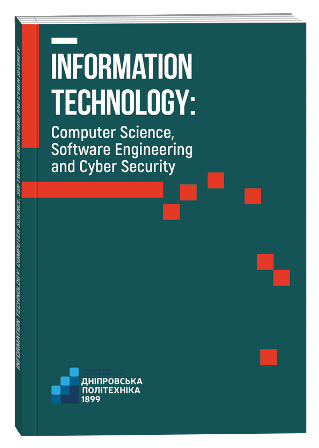METHODS OF MACHINE LEARNING OF THE NEURAL NETWORK TO PREDICT LARGE NOISY DATA USING MODERN PROGRAMMING LANGUAGES
DOI:
https://doi.org/10.32782/IT/2022-1-6Keywords:
noisy data, neural network, machine learning, programming language, transformation, finite values, big data.Abstract
The article describes the methods of machine learning of the neural network to predict large noisy data using modern programming languages. Features of construction of an artificial neural network, its essence and structure are described. It is emphasized that the implementation of the method of machine learning neural network to predict large noisy data using modern programming languages is carried out in two main stages: the first stage is the preprocessing of data that is noisy the resulting set suitable for further use, the second stage is a mechanism for separating the boundaries of the resulting result set. The local and adaptive approach is aimed at the implementation of the described first stage, the effectiveness of such an approach is emphasized and the main indicators of the impact on the initial data set are highlighted. The resulting factor is the possibility of a separate independent effect on each peak of the image, taking into account the initial characteristics. Mathematically formed the structure of an artificial neural network to predict large noisy data, describes each individual component that is part of the overall structure. It is noted that the approximation function is based on the input layers in the amount of three units and one output. It is emphasized that given the color of the initial data set, the priority is to establish a halftone, with a gradual transition to an artificial neural network for further processing, when leaving the neural network, color information is restored. The approach to the assessment of the quality of noisy data during prediction by an artificial neural network is described, it is emphasized that the minimization of the assessment value corresponds to the improvement of the visual quality of the image under consideration. The architecture of the neural network for predicting large noisy data is schematically presented: the input structure of the matrix is determined and the boundary matrix of the output is described. It is noted that the use of modern programming languages allows the creation, training, modeling, as well as import and export of neural networks and data, using only the tools of the interface.
References
Тимощук П. В. Спрощена модель нейронної мережі дискретного часу для паралельного сортування. Комп’ютерні системи та мережі. 2020. Т. 2. № 1. С. 94–101.
Сторчак К. П., Тушич А. М., Бондарчук А. П. Кластерний аналіз даних із використанням штучних нейронних мереж. Зв'язок. 2018. № 6 (136). С. 36-38.
Пронін С. В., Мірошниченко М. О. Система для аналізу великих масивів даних за допомогою алгоритмів машинного навчання. Вiсник Харкiвського нацiонального автомобiльно-дорожнього унiверситету. Харкiв, 2021. Вип. 94. С. 142–148.
Трочун Є. В. Спосіб інтерпретації результатів аудитів. Науковий огляд. 2021. № 4 (76). С. 36-45.
Training Neural Networks on Noisy Data / A. Rusiecki et al. Artificial Intelligence and Soft Computing. Cham, 2014. P. 131–142. URL: https://doi.org/10.1007/978-3-319-07173-2_13 (date of access: 16.04.2022).
Weak lensing cosmology with convolutional neural networks on noisy data / D. Ribli et al. Monthly Notices of the Royal Astronomical Society. 2019. Vol. 490, no. 2. P. 1843–1860. URL: https://doi.org/10.1093/mnras/ stz2610 (date of access: 16.04.2022).
A Hybrid Neural Network Model for Noisy Data Regression / E. W. M. Lee et al. IEEE Transactions on Systems, Man and Cybernetics, Part B (Cybernetics). 2004. Vol. 34, no. 2. P. 951–960. URL: https:// doi.org/10.1109/tsmcb.2003.818440 (date of access: 17.04.2022).
Learning Partial Differential Equations from Noisy Data using Neural Networks / K. Srivastava et al. Journal of Physics: Conference Series. 2020. Vol. 1655. P. 012075. URL: https://doi.org/10.1088/1742-6596/1 655/1/012075 (date of access: 17.04.2022).
On Neural Network Training from Noisy Data using a Novel Filtering Framework / V. Deshpande et al. AIAA Scitech 2020 Forum, Orlando, FL. Reston, Virginia, 2020. URL: https://doi.org/10.2514/6.2020-1869 (date of access: 17.04.2022).
Xie, Xuping & Bao, Feng & Maier, Thomas & Webster, Clayton. (2021). Analytic continuation of noisy data using Adams Bashforth residual neural network. Discrete & Continuous Dynamical Systems – S. 10.3934/ dcdss.2021088.
Calibrating multi-dimensional complex ODE from noisy data via deep neural networks / Li Kexuan, et al. arXiv preprint arXiv:2106.03591 2021. URL: https://www.researchgate.net/publication/352208410 _ Calibrating_multi-dimensional_complex_ODE_from_noisy_data_via_deep_ neural_networks (date of access: 17.04.2022).
Burger M., Heinz W. Engl. Training neural networks with noisy data as an ill-posed problem. Advances in Computational Mathematics. 2000. Vol. 13.4. P. 335-354.
Correction: On Neural Network Training from Noisy Data using a Novel Filtering Framework / V. Deshpande et al. AIAA Scitech 2020 Forum, Orlando, FL. Reston, Virginia, 2020. URL: https://doi.org/10.2514/6.2020-1869. c1 (date of access: 17.04.2022).
Neural Networks with Fixed Binary Random Projections Improve Accuracy in Classifying Noisy Data / Z. Yang et al. Bildverarbeitung für die Medizin 2021. Wiesbaden, 2021. P. 211–216. URL: https:// doi.org/10.1007/978-3-658-33198-6_51 (date of access: 17.04.2022).







